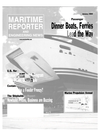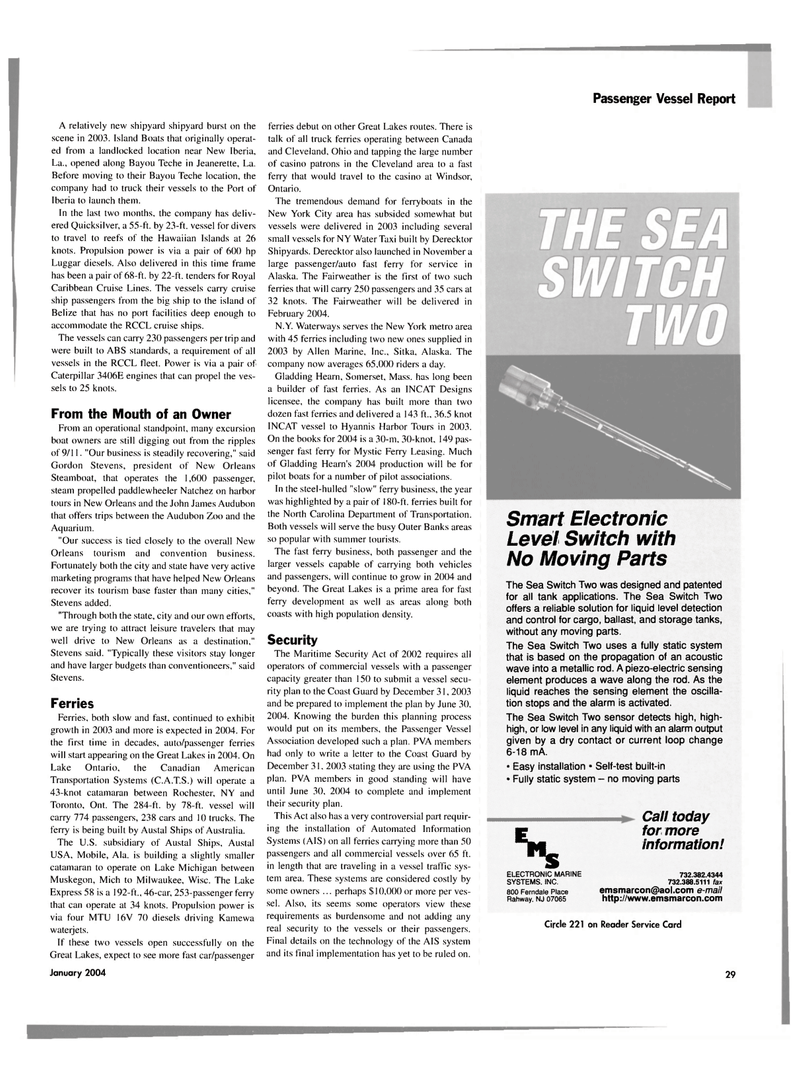
Page 29: of Maritime Reporter Magazine (January 2004)
Ferry & Passenger Vessel Yearbook
Read this page in Pdf, Flash or Html5 edition of January 2004 Maritime Reporter Magazine
Passenger Vessel Report
A relatively new shipyard shipyard burst on the scene in 2003. Island Boats that originally operat- ed from a landlocked location near New Iberia,
La., opened along Bayou Teche in Jeanerette, La.
Before moving to their Bayou Teche location, the company had to truck their vessels to the Port of
Iberia to launch them.
In the last two months, the company has deliv- ered Quicksilver, a 55-ft. by 23-ft. vessel for divers to travel to reefs of the Hawaiian Islands at 26 knots. Propulsion power is via a pair of 600 hp
Luggar diesels. Also delivered in this time frame has been a pair of 68-ft. by 22-ft. tenders for Royal
Caribbean Cruise Lines. The vessels carry cruise ship passengers from the big ship to the island of
Belize that has no port facilities deep enough to accommodate the RCCL cruise ships.
The vessels can carry 230 passengers per trip and were built to ABS standards, a requirement of all vessels in the RCCL fleet. Power is via a pair of
Caterpillar 3406E engines that can propel the ves- sels to 25 knots.
From the Mouth of an Owner
From an operational standpoint, many excursion boat owners are still digging out from the ripples of 9/11. "Our business is steadily recovering," said
Gordon Stevens, president of New Orleans
Steamboat, that operates the 1,600 passenger, steam propelled paddlewheeler Natchez on harbor tours in New Orleans and the John James Audubon that offers trips between the Audubon Zoo and the
Aquarium. "Our success is tied closely to the overall New
Orleans tourism and convention business.
Fortunately both the city and state have very active marketing programs that have helped New Orleans recover its tourism base faster than many cities,"
Stevens added. "Through both the state, city and our own efforts, we are trying to attract leisure travelers that may well drive to New Orleans as a destination,"
Stevens said. "Typically these visitors stay longer and have larger budgets than conventioneers," said
Stevens.
Ferries
Ferries, both slow and fast, continued to exhibit growth in 2003 and more is expected in 2004. For the first time in decades, auto/passenger ferries will start appearing on the Great Lakes in 2004. On
Lake Ontario, the Canadian American
Transportation Systems (C.A.T.S.) will operate a 43-knot catamaran between Rochester, NY and
Toronto, Ont. The 284-ft. by 78-ft. vessel will carry 774 passengers, 238 cars and 10 trucks. The ferry is being built by Austal Ships of Australia.
The U.S. subsidiary of Austal Ships. Austal
USA, Mobile, Ala. is building a slightly smaller catamaran to operate on Lake Michigan between
Muskegon, Mich to Milwaukee, Wise. The Lake
Express 58 is a 192-ft., 46-car, 253-passenger ferry that can operate at 34 knots. Propulsion power is via four MTU 16V 70 diesels driving Kamewa waterjets.
If these two vessels open successfully on the
Great Lakes, expect to see more fast car/passenger
January 2004 ferries debut on other Great Lakes routes. There is talk of all truck ferries operating between Canada and Cleveland, Ohio and tapping the large number of casino patrons in the Cleveland area to a fast ferry that would travel to the casino at Windsor,
Ontario.
The tremendous demand for ferryboats in the
New York City area has subsided somewhat but vessels were delivered in 2003 including several small vessels for NY Water Taxi built by Derecktor
Shipyards. Derecktor also launched in November a large passenger/auto fast ferry for service in
Alaska. The Fairweather is the first of two such ferries that will carry 250 passengers and 35 cars at 32 knots. The Fairweather will be delivered in
February 2004.
N.Y. Waterways serves the New York metro area with 45 ferries including two new ones supplied in 2003 by Allen Marine. Inc., Sitka, Alaska. The company now averages 65,000 riders a day.
Gladding Hearn, Somerset, Mass. has long been a builder of fast ferries. As an INCAT Designs licensee, the company has built more than two dozen fast ferries and delivered a 143 ft., 36.5 knot
INCAT vessel to Hyannis Harbor Tours in 2003.
On the books for 2004 is a 30-m, 30-knot, 149 pas- senger fast ferry for Mystic Ferry Leasing. Much of Gladding Hearn's 2004 production will be for pilot boats for a number of pilot associations.
In the steel-hulled "slow" ferry business, the year was highlighted by a pair of 180-ft. ferries built for the North Carolina Department of Transportation.
Both vessels will serve the busy Outer Banks areas so popular with summer tourists.
The fast ferry business, both passenger and the larger vessels capable of carrying both vehicles and passengers, will continue to grow in 2004 and beyond. The Great Lakes is a prime area for fast ferry development as well as areas along both coasts with high population density.
Security
The Mariti me Security Act of 2002 requires all operators of commercial vessels with a passenger capacity greater than 150 to submit a vessel secu- rity plan to the Coast Guard by December 31, 2003 and be prepared to implement the plan by June 30. 2004. Knowing the burden this planning process would put on its members, the Passenger Vessel
Association developed such a plan. PVA members had only to write a letter to the Coast Guard by
December 31, 2003 stating they are using the PVA plan. PVA members in good standing will have until June 30, 2004 to complete and implement their security plan.
This Act also has a very controversial part requir- ing the installation of Automated Information
Systems (AIS) on all ferries carrying more than 50 passengers and all commercial vessels over 65 ft. in length that are traveling in a vessel traffic sys- tem area. These systems are considered costly by some owners ... perhaps $ 10,000 or more per ves- sel. Also, its seems some operators view these requirements as burdensome and not adding any real security to the vessels or their passengers.
Final details on the technology of the AIS system and its final implementation has yet to be ruled on.
Smart Electronic
Level Switch with
No Moving Parts
The Sea Switch Two was designed and patented for all tank applications. The Sea Switch Two offers a reliable solution for liquid level detection and control for cargo, ballast, and storage tanks, without any moving parts.
The Sea Switch Two uses a fully static system that is based on the propagation of an acoustic wave into a metallic rod. A piezo-electric sensing element produces a wave along the rod. As the liquid reaches the sensing element the oscilla- tion stops and the alarm is activated.
The Sea Switch Two sensor detects high, high- high, or low level in any liquid with an alarm output given by a dry contact or current loop change 6-18 mA. • Easy installation * Self-test built-in • Fully static system - no moving parts s
ELECTRONIC MARINE
SYSTEMS. INC. 800 Ferndale Place
Rahway. NJ 07065
Call today for more information! 732.382.4344 732.388.5111 fax [email protected] e-mail http://www.emsmarcon.com
Circle 221 on Reader Service Card 29

 28
28

 30
30
